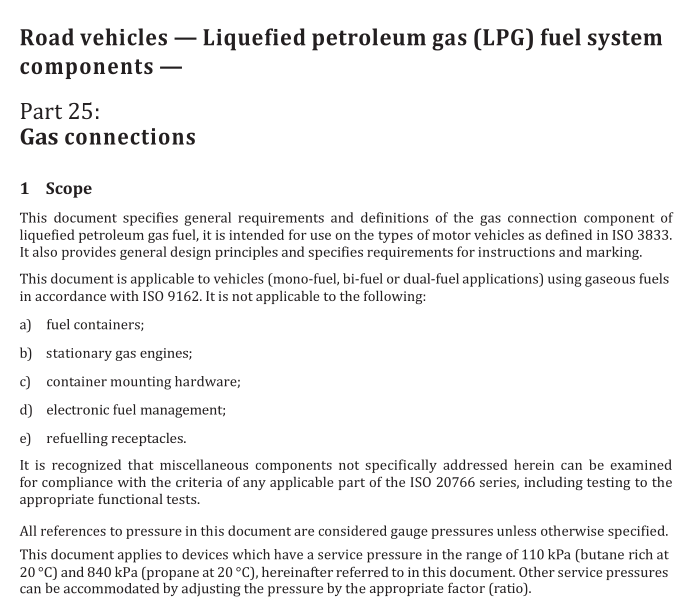ISO 20766-25 pdf download

ISO 20766-25 pdf download Road vehicles — Liquefied petroleum gas (LPG) fuel system components — Part 25: Gas connections
1 Scope
This document specifies general requirements and definitions of the gas connection component ofliquefied petroleum gas fuel, it is intended for use on the types of motor vehicles as defined in is0 3833.lt also provides general design principles and specifies requirements for instructions and marking.
This document is applicable to vehicles (mono-fuel, bi-fuel or dual-fuel applications)using gaseous fuelsin accordance with ISO 9162.It is not applicable to the following:
a) fuel containers;
b) stationary gas engines;
c)container mounting hardware;d)electronic fuel management;e) refuelling receptacles.
lt is recognized that miscellaneous components not specifically addressed herein can be examinedfor compliance with the criteria of any applicable part of the ISo 20766 series, including testing to theappropriate functional tests.
All references to pressure in this document are considered gauge pressures unless otherwise specified.This document applies to devices which have a service pressure in the range of 110 kPa (butane rich at20 °C) and 840 kPa (propane at 20 °C), hereinafter referred to in this document.Other service pressurescan be accommodated by adjusting the pressure by the appropriate factor (ratio).
2Normative references
The following documents are referred to in the text in such a way that some or all of their contentconstitutes requirements of this document. For dated references, only the edition cited applies. Forundated references, the latest edition of the referenced document (including any amendments) applies.ISO 20766-1, Road vehicles —Liquefied petroleum gas (LPG) fuel systems components — Part 1: Generalrequirements and definitions
ISO 20766-2,Road vehicles – Liquefied petroleum gas (LPG) fuel systems components — Part 2:Performance and general test methods
3Terms and definitions
For the purposes of this document, the terms and definitions given in IS0 20766-1 apply.
IlsO and IEC maintain terminology databases for use in standardization at the following addresses:- ISo Online browsing platform: available at https://www.iso .org/obp
4 Markings
Marking of the component shall provide sufficient information to allow the following to be traced:a) the manufacturer’s or agent’s name, trademark or symbol;
b) the model designation (part number);
c)the working pressure or working pressure and temperature range;d) the serial number or date code; and
e) the direction of flow (when necessary for correct installation).The following additional markings are recommended:
– the type of fuel;
the electrical ratings (if applicable);the symbol of the certification agency;the type approval number; and
– a reference to this document.
NOTE This information can be provided by a suitable identification code on at least one part of the componentwhen it consists of more than one part.
In the event that a component cannot accommodate all marking requirements listed in this document,the manufacturer shall include missing marking information with the packaging of the component.
5Construction assembly
The gas connections shall comply with the applicable provisions of IS0 20766-1 and ISo 20766-2, andwith the tests specified in Clause 6.
Soldered or welded joints are not permitted. Soldering or welding can be permitted for connecting theindividual parts of detachable couplings to the gas tube or component.
Gas tubes shall only be connected by compatible fittings with regard to corrosion.Gas tubes and couplings should mate to avoid galvanic corrosion.
Distributing-blocks shall be made of corrosion-resistant material.
Gas tubes shall be connected by appropriate joints or fittings.Under no circumstances joints or fittingsmay be used whereby the tube will be damaged.The burst pressure of the joints or fittings shall be thesame or higher as specified for the tube.
The number of joints or fittings shall be limited to a minimum.
Any joints shall be made in locations where access is possible for inspection.
There shall be no gas-conveying connections in the passenger compartment or enclosed luggagecompartment with the exception of:
a) the connections in the gas-tight housing; and









